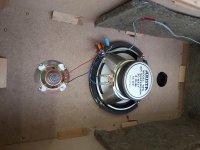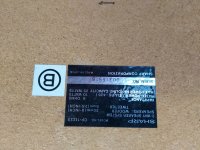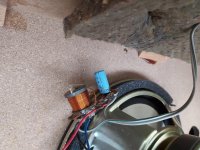I dug these out of storage yesterday. I had them in my bedroom during my teenage years. I hooked them up and they still work fine. Sound is actually not too bad. Bass is not that deep but ok for 8in drivers. Mids and highs a touch harsh.
I recently built my first set of speakers (Overnight Sensations - not from a kit). I was interest to look at the speakers and crossover so I took the back off.
I was surprised to find only an inductor and cap for the crossover. I also noticed that the Tweeter was branded Sharp but the woofer is Arista brand. Am guessing it is not the original. There is a vent hole on the front bafflle but no port tube.
I cannot find any info online for the model of woofer. My immediate thought was why such a basic crossover. Is it because they were just low end speakers, or because the specs of the original tweeter and woofer might have been designed in such a way that this was all that is required? Makes the crossover in the OS speakers look very elaborate.
My next thought was that if the woofer has been replaced, has there been any consideration given to the choice of replacement at all.
The speakers look in very good condition and enclosure is in reasonable condition. I know they are nothing flash but in diy spirit and also largely as a learning experience I am wondering if I can improve them, otherwise I will just use as is.
What would be best approach here - try to find specs of the speaker and improve the crossover? Replace the woofer and also crossover?
I was hoping to find some reference to sensitivity as would ideally like some speakers that are more sensitive that the OS as I'm planning a Class A build most likely jlh 69. They seem too old and uncommon and perhaps too cheap to have detailed info still available. Made in Japan though! Cap is Nichicon. Inductor looks like ?iron core.
I recently built my first set of speakers (Overnight Sensations - not from a kit). I was interest to look at the speakers and crossover so I took the back off.
I was surprised to find only an inductor and cap for the crossover. I also noticed that the Tweeter was branded Sharp but the woofer is Arista brand. Am guessing it is not the original. There is a vent hole on the front bafflle but no port tube.
I cannot find any info online for the model of woofer. My immediate thought was why such a basic crossover. Is it because they were just low end speakers, or because the specs of the original tweeter and woofer might have been designed in such a way that this was all that is required? Makes the crossover in the OS speakers look very elaborate.
My next thought was that if the woofer has been replaced, has there been any consideration given to the choice of replacement at all.
The speakers look in very good condition and enclosure is in reasonable condition. I know they are nothing flash but in diy spirit and also largely as a learning experience I am wondering if I can improve them, otherwise I will just use as is.
What would be best approach here - try to find specs of the speaker and improve the crossover? Replace the woofer and also crossover?
I was hoping to find some reference to sensitivity as would ideally like some speakers that are more sensitive that the OS as I'm planning a Class A build most likely jlh 69. They seem too old and uncommon and perhaps too cheap to have detailed info still available. Made in Japan though! Cap is Nichicon. Inductor looks like ?iron core.
Attachments
The inductor and capacitor form a 1st order crossover (6 dB / oct).
The hole is the port.
You can measure the speaker parameters yourself. Read the forum and the Internet.
SHARP CP-1122X 2-Way Speakers (25 Watts - 8 Ohms), made in Japan.
Approx Dimensions: 31 x 26 x 64 cm (each speaker)
The hole is the port.
You can measure the speaker parameters yourself. Read the forum and the Internet.
SHARP CP-1122X 2-Way Speakers (25 Watts - 8 Ohms), made in Japan.
Approx Dimensions: 31 x 26 x 64 cm (each speaker)
Last edited:
The phrase "engineered to a price-point" springs to mind, and if they've been repaired that doctrine was carried forward into the repair! If you have a limited budget spending a lot of it on the size of box isn't such a bad idea.
If its been altered the tweeter/bass driver balance may be off, giving the harshness / lack of bass.
If its been altered the tweeter/bass driver balance may be off, giving the harshness / lack of bass.
I dug these out of storage yesterday. I had them in my bedroom during my teenage years. I hooked them up and they still work fine. Sound is actually not too bad. Bass is not that deep but ok for 8in drivers. Mids and highs a touch harsh.
I recently built my first set of speakers (Overnight Sensations - not from a kit). I was interest to look at the speakers and crossover so I took the back off.
I was surprised to find only an inductor and cap for the crossover. I also noticed that the Tweeter was branded Sharp but the woofer is Arista brand. Am guessing it is not the original. There is a vent hole on the front bafflle but no port tube.
I cannot find any info online for the model of woofer. My immediate thought was why such a basic crossover. Is it because they were just low end speakers, or because the specs of the original tweeter and woofer might have been designed in such a way that this was all that is required? Makes the crossover in the OS speakers look very elaborate.
My next thought was that if the woofer has been replaced, has there been any consideration given to the choice of replacement at all.
The speakers look in very good condition and enclosure is in reasonable condition. I know they are nothing flash but in diy spirit and also largely as a learning experience I am wondering if I can improve them, otherwise I will just use as is.
What would be best approach here - try to find specs of the speaker and improve the crossover? Replace the woofer and also crossover?
I was hoping to find some reference to sensitivity as would ideally like some speakers that are more sensitive that the OS as I'm planning a Class A build most likely jlh 69. They seem too old and uncommon and perhaps too cheap to have detailed info still available. Made in Japan though! Cap is Nichicon. Inductor looks like ?iron core.
It is unusual to have a reflex port that is a hole.
Altronics sell adjustable reflex ports that would allow some tuning of the bass. Another test option would be to block the hole temporarily by putting a sock in it.
Altronics sell adjustable reflex ports that would allow some tuning of the bass. Another test option would be to block the hole temporarily by putting a sock in it.
Thanks. Yes they were the ports I used for my OS.
Is a subjective approach to this as good as any or should I be trying to calculate a length using on of the online calculators based on a desired tuning frequency?
I have emailed Arista on the off chance that they might be able to provide some specs on the woofer. Presumably if I had a grapg of frquency response I might be able to tweak the crossover? Changing the cap would be cheap and easy. The inductor less so.
I have emailed Arista on the off chance that they might be able to provide some specs on the woofer. Presumably if I had a grapg of frquency response I might be able to tweak the crossover? Changing the cap would be cheap and easy. The inductor less so.
Is a subjective approach to this as good as any or should I be trying to calculate a length using on of the online calculators based on a desired tuning frequency?
I have emailed Arista on the off chance that they might be able to provide some specs on the woofer. Presumably if I had a grapg of frquency response I might be able to tweak the crossover? Changing the cap would be cheap and easy. The inductor less so.
If you tuned your new speakers using adjustable reflex ports you would know the drill to go through. I have done this using calculators but in the end I relied more on testing by ear.
If there are differences in sensitivity where the tweeter is too prominent you could buy an L Pad from Wagner Electronics and use that for test purposes on both speakers and substitute wire resistors for the values closest to those resulting in each pad half.
Again this can be done by ear but the process requires some patience and getting there is small steps allowing time to test with various genres of music. If you are unsure you could just buy two L Pads and adjust according to mood.
If you tuned your new speakers using adjustable reflex ports you would know the drill to go through. I have done this using calculators but in the end I relied more on testing by ear.
I just relied on Paul Carmody's recommended 6in length. I did read in one of his posts on a forum where he admitted to actually making a miscalculation regarding this as this length was more like a 58Hz tuning frequency rather than the 53Hz he published on his website. He said it sounded good at that length so he left it. I have just put a bead of silicone to seal mine in.place so wouldn't be hard to do some experimenting later. Bit of a pain with those adjustable ports though that the sliding part has slightly larger diameter to the mouth so you have to take the front baffle off to seal it in place. I will have to read about the procedure to tune the port.
Thanks for the advice.
Last edited:
- Status
- This old topic is closed. If you want to reopen this topic, contact a moderator using the "Report Post" button.
- Home
- Amplifiers
- Solid State
- Sharp CP-1122x 2 way speakers


